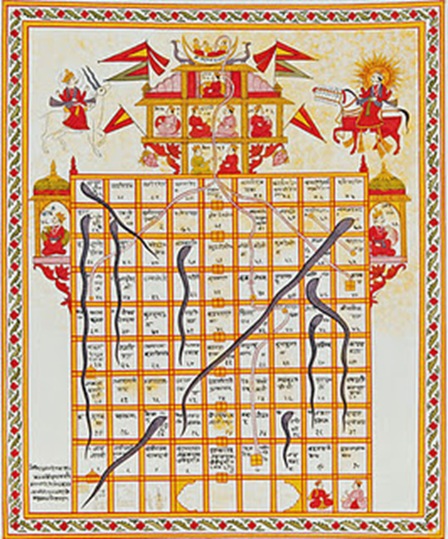
以下引自 Shravasti Dhammika 比丘的部落格〈Dhamma Musings〉
http://sdhammika.blogspot.com/2012/01/snakes-and-ladders.html
I have always liked the Jains. During my travels throughout India every Jain I have met without exception has been respectful, helpful and generous. When I visited Palitana in Gujarat the only problem was that they wouldn’t let me leave, so intent were they on offering me their hospitality.
我一直都很喜歡耆那教徒。在我深入印度的旅遊當中,每一位我遇到的耆那教徒都毫無例外的可敬、樂意助人與慷慨好客。當我訪問古佳拉特省的巴利坦那時,我唯一的問題是他們不讓我離去,他們是如此堅決地要我接納他們的好客邀請。
Now that I have discovered that the Jains invented Snakes and Ladders I like them even more. As a child, my older sister and I and the kids next door used to play this game all the time. I can still remember the snake’s head in the square Pride and its tail in the square Fall. Tradition says that the Jain saint Gaydev invented Snakes and Ladders in the 13th century to teach children the cardinal virtues. This story is perfectly plausible. Anyone who has ever stayed with Jain monks will know how diligently and creatively they minister to the lay community. The great Indiologist A. L. Basham thought that one of the reasons why Buddhism disappeared in India and Jainism didn’t was because of the attentiveness of the Jain monks towards the laity. It’s an interesting theory.
當我發現是耆那教徒發明了「蛇梯棋」時,我更加喜歡他們。小時候,我姊、我和鄰居小孩經常在玩這個遊戲。我仍然記得「蛇梯棋」裡頭的蛇,頭在「榮譽」這一格,而蛇尾在「墮落」這一格。依照傳說,是耆那教聖人 Gaydev 在13世紀發明了「蛇梯棋」來教導兒童「基本道德」。這個故事相當合理,每一個曾經與耆那教僧侶相處的人都發現他們多麼勤奮認真與具創意地教導他們的信徒。偉大的印度學專家 A. L. Basham 認為,佛教在印度斷滅而耆那教衍續下來的主要原因之一是,耆那教僧侶對其信徒的關注。這是個相當有趣的說法。
The Jains call Snakes and Ladders Moksha Patamu, Liberation and Decline, which would be Mokkha Patana in Pali. I wonder if the Buddhists of ancient Gujarat played Snakes and Ladders too. The most ancient version of the game have 72 squares and the virtues are faith, reliability, generosity knowledge and simplicity. The vices are disobedience, vanity, rudeness, theft, dishonesty, drunkenness, debt, killing, anger, greed, pride and lust. The last square on the top left is Nirvana. What a delightful and fun way to teach children basic goodness! I suspect that young kids today would be bored stiff by Snakes and Ladders. It wouldn’t have a chance against video games. But to me the game brings back fond memories of a more simple and innocent time.
耆那教徒稱蛇梯棋為「Moksha Patamu, 解脫與墮落」,相當於巴利「Mokkha Patana」。我懷疑是否古代位於古佳拉特省的佛教徒也會玩蛇梯棋。這遊戲最古老的版本有72格,「德行」有「信、精進、布施、智慧、單純」。反面有「叛逆、虛榮、粗魯、盜竊、不誠實、酗酒、舉債、殺生、瞋、貪、慢與多欲」。最高的中點是左上方那一格「涅槃」。這是教導兒童基本道德的多麼有趣而充滿歡笑的方法!我懷疑今日的兒童會覺得蛇梯棋無聊到爆,它要對抗電腦遊戲是沒有任何勝算的。但是對我來講,蛇梯棋又帶給我對那段單純而無邪年代的記憶。
Posted by Shravasti Dhammika at 1:44 PM
--------------------------------------------------
 peace said...
peace said... this is such an interesting post! thank you Bhante. i also wonder if the snake (that punishes one in the game) has any link to the idea of the snake in the garden of eden. hmmm... yes, thanks again Bhante!
January 19, 2012 2:51 AM
 Shravasti Dhammika said...
Shravasti Dhammika said... Dear Peace,
In India the snake is never associated with evil. In this game the snake’s role is not to punish but to slide down. You climb the ladder and slide down the snake’s smooth (i.e. slippery) body.
January 19, 2012 4:43 AM
===============================================================
蛇梯棋(Snakes and Ladders),是源自於印度的「擲骰子遊戲」,棋盤上除方格外,還繪有梯子、蛇,以骰子隨機決定棋子的步數,途中若抵達梯子或蛇的格子會移至其他格,以抵達終點為勝利。
----------------------------------------------------------------------
這裡可以玩蛇梯棋
http://www.vam.ac.uk/vastatic/microsites/1414_jain/snakesandladders/
===================
以下引自:’Leela, the game of knowledge’
http://www.sanatansociety.com/hinduism_books/hb_leela_karma.htm
Four things are necessary for one or more to play Leela: the Leela book and game board, a die (of karma) and a significant object that belongs to the player, such as a ring, to serve as the player's symbol during the game. Each of the seventy-two squares on the board of Leela represents a virtue or vice, an aspect of human consciousness or a plane of being. The players' progress is dictated by the fall of a die corresponding to the forces of karma. The seven planes through which the player must pass before he reaches the eighth plane - the plane beyond all planes - are the seven chakras. Leela is not merely an entertainment but a serious method of understanding the phenomenal world of Maya (Illusion), and the spiritual nature of our individual self that leads us to the journey towards liberation.
The saints who invented this game used the game-board to recognize the present state of their own being. By playing the game time and again they consciously observed which snake brought them down and which arrows took them up. Observing their own inner self, they could tell whether they had understood what it is to be not involved. The uniqueness of Leela - the game of self-knowledge - is that it is a study of scriptures and discovery of the self at the same time.
--------------------
 mormolyca 提到...
mormolyca 提到...
-
前兩天看到這篇文章,也上網查了一下,蛇頭的部分大概是貪嗔癡這些內容,棋者走到這幾個格子就會被蛇咬,要滑到蛇尾巴的格子,而梯子的部分則是助緣,棋者透過這些助緣則可向上提昇到梯子上端,網路上還有個完全仿效該棋圖的線上遊戲版:
http://www.vam.ac.uk/content/articles/j/snakes-and-ladders/2012年1月21日上午10:29
-
 藏經閣外的掃葉人 提到...
藏經閣外的掃葉人 提到... -
值得注意的是這樣的主張,我曾遇到過一位出家人勸導我淨信與念佛就好,不需要去修定與多聞佛法。
偉大的印度學專家 A. L. Basham 認為,佛教在印度斷滅而耆那教衍續下來的主要原因之一是,耆那教僧侶對其信徒的關注。這是個相當有趣的說法。
這一講法在討論「佛教斷滅與耆那教繼續存在」時,斷斷續續聽過學者與長老比丘提到過。2012年1月21日上午10:37

2 則留言:
前兩天看到這篇文章,也上網查了一下,蛇頭的部分大概是貪嗔癡這些內容,棋者走到這幾個格子就會被蛇咬,要滑到蛇尾巴的格子,而梯子的部分則是助緣,棋者透過這些助緣則可向上提昇到梯子上端,網路上還有個完全仿效該棋圖的線上遊戲版:
http://www.vam.ac.uk/content/articles/j/snakes-and-ladders/
值得注意的是這樣的主張,我曾遇到過一位出家人勸導我淨信與念佛就好,不需要去修定與多聞佛法。
偉大的印度學專家 A. L. Basham 認為,佛教在印度斷滅而耆那教衍續下來的主要原因之一是,耆那教僧侶對其信徒的關注。這是個相當有趣的說法。
這一講法在討論「佛教斷滅與耆那教繼續存在」時,斷斷續續聽過學者與長老比丘提到過。
張貼留言